EARLY ON
History of Columbiana County, Ohio - Harold B. Barth Historical Publishing Company 1926,CHAPTER XVIII, CHURCHES, CONTINUED:
Under spreading trees, in private houses and within tents early Columbiana County residents worshipped God publicly and heard the preaching of the Gospel. Always its religious atmosphere grew and proved an inspiring and comforting impetus throughout the multitudinous vicissitudes of the initial phase of its existence which, in its mature years, has established it as a community of high moral tone, one inculcated in Christian doctrine and given to a breadth of equity in the varied human relationships of its inhabitants.
It was a Methodist minister, Rev. Robert Dobbins, of Yellow Creek, who preached first to an East Liverpool audience which, few in number, greeted him in the open in 1799. He filled in at every opportunity. Then, from Calcutta, came the Presbyterian preachers, Revs. Thomas E. Hughes and John Scott, who, as evangelists, had with others been holding revivals throughout the outlying settlements. Episcopalians erected the first church within the present city confines and the Roman Catholic Church followed with the second built structure. Then, in turn, as the population mounted the various denominations became active in organization and resultant building of places of worship until by 1925 East Liverpool has more than 35 church and missions, some fitted with every modern appointment and all carrying a value exceeding $1,000,000, with a total membership of more than 12,000 in all the different denominations.
Although there is no firm basis for determining the effects of churches on a community, organized religion had a stabilizing effect upon the residents and the town. Even though Thomas Fawcett was a Quaker, there is no record that a meeting house was ever established in his village. The religious needs of the residents were probably met by transient preachers who held services and then moved on to other locations. Spurred on by the "Great Awakening," several Protestant groups organized congregations and constructed churches in East Liverpool during the 1830s. The first group to organize was the Episcopals in 1834. In that same year, the group built the first church in town on the Fourth Street lot donated for religious purposes by Fawcett, Moore, and Pemberton.136 Horace Mack, who was able to interview residents, states that a Methodist Episcopal group began to organize in 1827. In July 1837 James Blakely, true to his word, gave Abel Coffin, William Phillips, John Patrick, Jesse Johnson, and Richard Manley land next to lot number 121 in the town" . . . for a meeting house and residence for their preacher . . ." The trustees immediately began the construction of a church. In April of 1833 Blakely also gave a lot in the vicinity of the town (now Fourth and Monroe Streets) to the trustees of the First Presbyterian Church.139 This group incorporated themselves in 1840, but delayed the building of their sanctuary until the next decade.
James Blakely, a devout Catholic, also aided his religion in the establishment of a church. On 4 November 1837 he, and other landowners, donated three lots in their new addition to the Right Reverend John B. Purcell of Cincinnati, trustee for the "Roman Catholic Congregation of Liverpool." These lots constituted a complete block at the corner of College and Robinson Streets. Encouraged by this gift and other financial contributions, East Liverpool's Catholics began erecting their church. Requiring additional funds, they appealed for assistance to other Catholic groups stating that they were ". . . encouraged by the promising state of the times, and the prospect of a considerable increase in our numbers from a public work then under contract (Ashtabula, Warren and Liverpool Railroad) . . . a substantial edifice (forty by seventy feet, of brick) . . ." has been built. How much money they received from their appeal is unknown. The church was completed and then almost immediately destroyed by fire in 1838. The congregation was forced to regroup, pay its debts, and meet in Blakely's home until another structure could be built. [Hills and Kilns pg. 28]
Despite denominational differences, the religious life of the community between 1840 and the end of the Civil War appeared to be fairly conventional and probably acted as a stronger agent of integration than other institutions in East Liverpool. By 1853 there was one Catholic and five Protestant congregations active within the town. In addition to the Episcopal church built in the late 1830s, the Catholics built a second church on Fifth Street in the wake of the disastrous fire of 1838. The United Presbyterian congregation erected a frame church on the corner of Market and Fifth Streets and a separate group calling themselves the First Presbyterian Church constructed a sanctuary on Third Street. Methodists organized in East Liverpool in 1855. They met in Bradshaw Hall until 1857 when they purchased the Sons of Temperance Hall on Fifth Street to use as a church. Most of the Protestant sects, despite differences in doctrine, reflect the AngloSaxon legacy of the general population. The Evangelical Lutherans were indicative of the growing number of Germans who by 1850 constituted the second largest immigrant group in the community. They began meeting as early as the mid-1850s, but did not build a church until after the Civil War. The Methodists appeared to be especially active. In 1850 not a single clergyman is listed as a resident of East Liverpool. The census of 1860, however, reveals three ministers in the community, all of whom were Methodists. If the interpretation of Episcopal records by the group in later years is accurate, this sect was apparently on the wane during much of the 1850 and 1860s. Church records indicate that "less than a score [was] communing" despite the fact that two hundred persons had been baptized in the church and lived within a three-mile area. The congregation even rented its structure to other groups. Although the edifices constructed by religious groups were not pretentious, the structures offered a sense of permanence and maturity to the community and provided places to meet, pray, and socialize. The existence of organized congregations undoubtedly helped to stabilize the moral and religious environment, as well as making a positive contribution to the social integration which bound the community together. [Hills and Kilns pg. 60]
Churches also played a major role in the changing cityscape of the "Crockery City." The construction of elaborate new churches by a number of denominations during the same period reflects a form of community expression through architecture, a growing population, and the desire to serve the needs of the individual organizations. The steeples of several churches built during this period were at least equal to, and sometimes just a little higher than, the existing ones in the city. In 1892 there were fourteen churches in East Liverpool, one Catholic and the rest Protestant sects including the First African Methodist Episcopal Church. The combined value of their buildings exceeded $325,000. Most congregations located their churches in the western sections of Third, Fourth, and Fifth Streets on the fringe of the business district. St. John's Lutheran Church was built on the corner of Third and Jackson Streets in 1896 and the First Baptist Church was erected in 1908 on west Fifth Street. As suburban areas in East Liverpool developed, new congregations established new churches in outlying areas or separated from existing groups to construct new edifices. In the northside, a Methodist Episcopal group completed a new church in 1907 on Orchard Grove Avenue. Will Thompson donated a lot on Park Boulevard in 1910 to construct the Emmanuel Presbyterian Church. At least three congregations erected churches during the first decade of the twentieth century in the developing east end area. [Hills and Kilns pg.212]
SOME HISTORY OF INDIVIDUAL CHURCHES - DENOMINATIONS
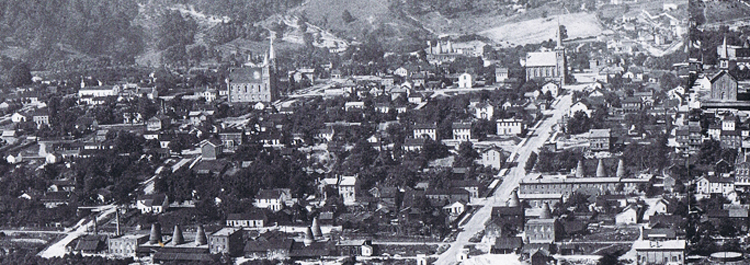
As this 1876 photograph show there were four churches relatively close to one another. The church shown in the photograph on the far left is the Methodist Episcopal Tabernacle. It was located on the corner of Jackson and 5th Street.
One block south of the church mentioned above and half a block to the left is a small white building which would be St. Stevens Protestant Episcopal Church.
The church in the center is the First United Presbyterian Church located at the corner of Market and 5th Street.
The church on the far right is the First Presbyterian Church.
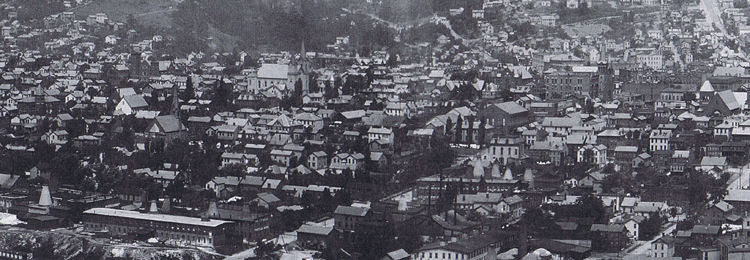
This particular photograph from 1898 shows seven churches in close proximity. A couple of them are hard to see but they are in the picture.
Starting at the far left is the (1) Methodist Episcopal Tabernacle. Directly below it, about two blocks, you can see the (2) St.John's Lutheran Church on Third Street.
Letting your eye move to the left a little ways you can easily see Third Street School and directly behind it and a little to the right is the (3) St. Stephens Protestant Episcopal Church.Looking almost directly up you can see (4) St. Al's Catholic Church.
Looking right, almost in the center of the picture but slightly to the left of the third church is the (5) Methodist Protestant Church.
It appears as if the Methodist Protestant Church and the next church as you continue looking right are touching but in fact there are a couple buildings between them. That church is the (6)First United Presbyterian Church.
The last church , at the far right, is a rebuilt (7)First Presbyterian Church which was located at the corner of East 4th Street and Mulberry Alley.

The same three churches are visible. Far left the Methodist Church, slightly to the right of center is the MP Church and the First United Presbyterian Church is at the far right in the Photograph. By 1912 that building was no longer owned by a religious denomination and the church was no longer used as a church. The other two in the picture still are active churches.
ST. STEPHENS PROTESTANT EPISCOPAL CHURCH
Not until 1834 was an effort made to build a church in East Liverpool though meetings were held in the log school house and the later brick one on the present site of the Fourth Street Common School, when inclement and cold weather prevented outside services. In that year the Episcopal congregation, just organized, put up a frame structure on Fourth Street on the same site now similarly utilized which was contributed by James Penderton, John Moore and Thomas Fawcett, the town's second owners. It was designated as St. Stephen's Protestant Episcopal Church.
The first sermon preached in it was by the Rev. Thomas Mitchell, who became the initial rector. He was followed by the Revs. Thomas Adderly, James Goodwin, Edmund Christian, Mr. Butler, T. K. Rodgers, T. K. Coleman, Mr. McKay, Mr. Gilbert, Phillip McKim, Mr. Burke, Jesse C. Taylor, Frederick Williams and Rev. Mr. O'Meara.
In 1879 on an adjoining lot the original church was replaced by what was known as "The Bell Church."
The membership then was about 30, the attendance 150 and the Sunday School 125. The new structure, of brick, cost $6,000. It was destroyed by fire in 1899.
The building to the right and behind the church ruins is Third Street School.
A beautiful stone edifice replaced the lost church at a cost of $8,000 and was dedicated on Dec. 26, 1900, by Bishop W. A. Leonard, of Cleveland.
The pastor was Rev. Edwin Weary, who continued as such until 1902. Then followed in turn, Revs. Robert Kell and Lionel C. Difford. The former, going to Baltimore, Md., in 1919, was succeeded by the latter who remained in charge until his demise on Jan. 26, 1926, following a year's illness. He was buried in Riverview Cemetery.
In 1922-23 a commodious parish house was built between the church and the parsonage at a cost of $40,000. It was dedicated on Sept. 17, 1923 by Bishop Frank Du Moulen, of Cleveland, with Rev. Lionel C. Difford as the rector.
At the annual meeting of the church on Feb. 2, 1926 the old vestry was re-elected as follows: senior warden, Albert Carnes; junior warden, W. H. Thompson; treasurer, R. A. Weinhardt; clerk, George Steel; financial secretary, Clifford Hindley, R. J. Shepherd, A. M. Burns, Robert M. Cartwright, John B. McDonald, Charles Nelson and John Parker.
Currently
METHODIST EPISCOPAL TABERNACLE
History of Columbiana County, Ohio - Harold B. Barth Historical Publishing Company 1926,CHAPTER XVIII, CHURCHES, CONTINUED:
Methodists during the early East Liverpool days first held their services in the various homes of those belonging to their denomination. Then followed meetings in the initial hewn log school house on the present site of Central School Building on Fourth Street which were in charge of the circuit riders of that period.
In 1827 the Rev. George Brown, of Wheeling, W.Va., organized the first Methodist class at the home of Claiborne Simms, Jr. It consisted of Mr. and Mrs. Jesse Johnson; Mr. and Mrs. James and William Warrick; the Fawcett Sisters, Mr. and Mrs. Claiborne Sims, Mrs. Robert Fawcett, MR. and Mrs. Simeon Johnson, Mrs. Nancy Anderson, Mr. and Mrs. William G. Smith, Mrs. Abagail Smith, Mr. and Mrs. Samuel Lyon, John Lyon, Mr. and Mrs. Able Coffin, Mr. and Mrs. Benjamin Davidson and others. Then followed the forming of the Sunday School with Jesse Johnson as initial superintendent. One of the earliest singers who often led the music in the class meetings was Mrs. Nancy Anderson. She also combined the work of village nurse and church janitor in her effort to aid the work then being done. Here, in one of these religious sessions, Adam Poe, son of the famous Indian fighter, became convicted of his sins and later was converted as he rowed home across the Little Beaver Creek. He later became a Methodist preacher.
By a strange coincidence the Fifth and Jackson Streets lot, at least 50x90 feet of it on which the original Methodist Church stood was procured from a Catholic, James Blakely, who was associated with William G. Smith, grandson of the town's founder, in the real estate business. Both wished to further the interests of Christianity in the community. They donated a lot, that on which part of the Vodrey pottery now stands to the Catholic residents and certain other property was traded to Mr. Blakely for the Methodist plot. Thus, Mr. Smith donated the site for the initial church in 1836 when he was 33 years of age. In the following year a square edifice with a stone basement and an upper section of brick was thereon erected. With the old log school house dilapidated the members began holding services in the basement ere the remainder of the structure was completed. This was continued for several years since sufficient funds for its completion were not forthcoming. William Phillips and his wife, Susannah Phillips, who lived at the present site of Dixonville, mortgaged their farm to raise the necessary money. Accordingly the church was generally known as "Father Phillip's Church."
Among those aiding in these basement services were the Bennett brothers, who operated the first pottery in the city. Edwin Bennett, who later removed to Baltimore and lived to be the oldest manufacturing potter in America, frequently preached in these meetings, he having qualified as a local preacher.
This church would become known as the First Methodist Church.
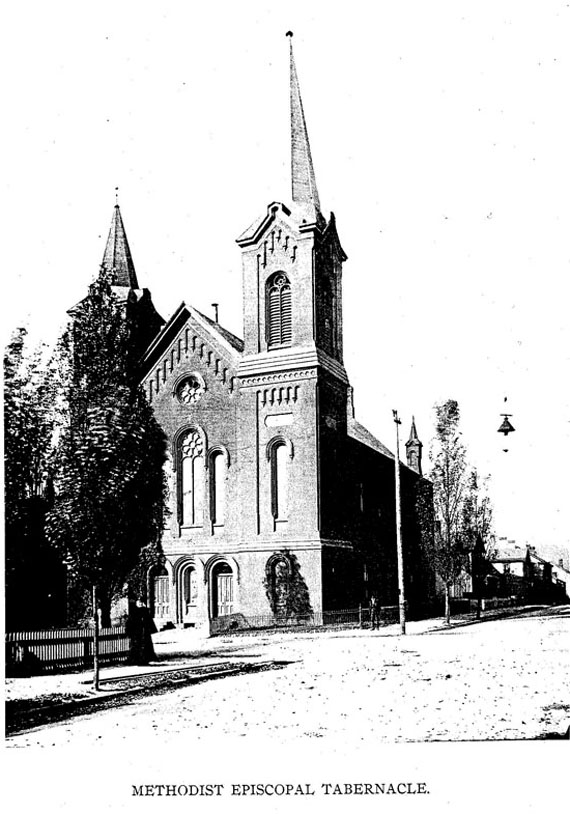
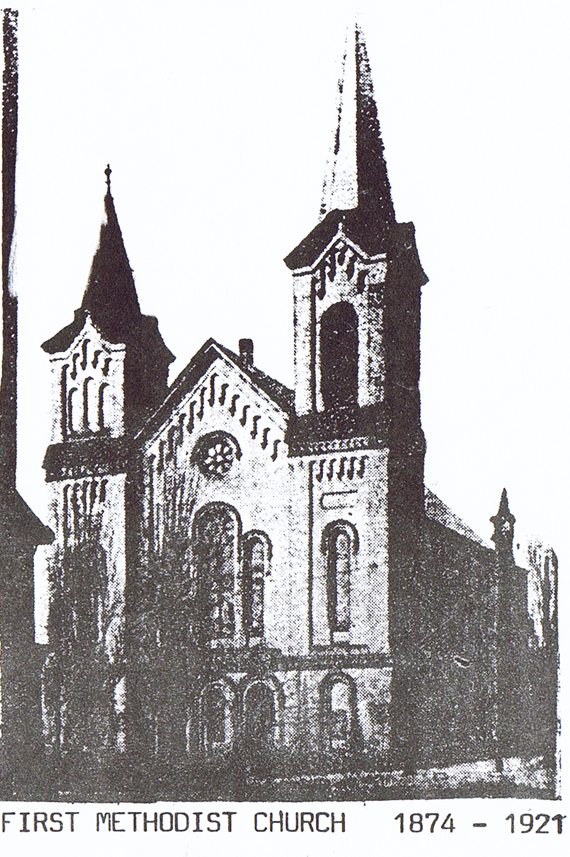
Initially we had the following two pictures as being the interior of the Methodist Protestant Church. Bradley Bonam, the current (May 2013)organist at the First United Methodist Church of East Liverpool informed us that thess pictures were in reality the interior of the Methodist Episcopal Church. A few day latewr, as time presented itself, we were able to lay all the pictures we had of both churches, including the fire pictures found in Part 3 of this article side by side, reread all the historical text we had and determined he was correct. We thank Mr. Bonam for bringing this to our attention.
This particular picture of an existing picture, we found in one of the rooms of the church, was taken by us on June 16, 2012 when we photographed the exterior and interior of the First United Methodist Church of East Liverpool. It had sat in a file on our computer until we returned to those pictures just a few days ago to create a 5 part article on that church for the web site. In the process of doing that we once again run across this picture which aided in determining where the other two pictures above belonged.
A new First Methodist Church would be built on the same spot to replace that one above.
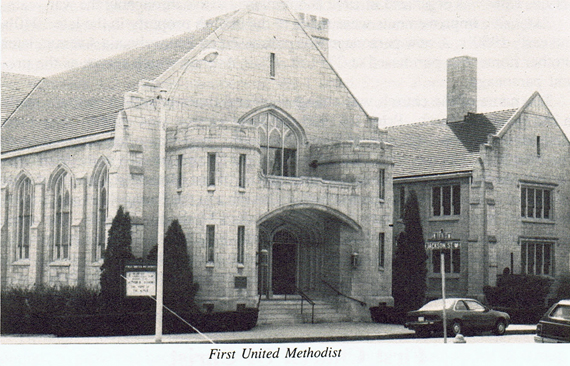
In 1827 Claiborn Simms, Sr. hosted a meeting for a small group to hear a Methodist Circuit Rider from Virginia on beginning a place of worship here. The group organized a class, and was granted permission to use the log school house which stood on the hillside south of the present Carnegie Public Library. The first Methodist Society was formed in East Liverpool.
A lot on 5th and Jackson Streets was donated in 1836 by William G. Smith. Construction began the following year. When work on the church progressed enough, services were held in the basement.
A resolution was passed in 1872 to erect a new church on the old site. The adjoining 60 feet of frontage on 5th Street was purchased by David Boyce for $500. At this time the congregation worshipped in a building across Jackson Street known as the Tabernacle.
The new church was completed and furnished, and a parsonage was erected. It was during this time that the Dorcas Society was formed comprised of the middle aged and elderly women of the church. Sorosis was organized the following year to interest young women in church work.
By 1887 East Liverpool was growing from the expansion of the pottery industry. The first church helped establish the Pennsylvania Avenue Church in East End.
At the turn of the century, the Rev. Milton B. Pratt was named pastor. Between 1908 and 1910 two more congregations came into being. One built a small chapel on land donated by David Boyce and located in the upper part of East End. The church was known as the Boyce Methodist Church. The second mission was started on Sheridan Avenue in the West End which was named Anderson-Methodist Church.
When Dr. Isaac Wood was named pastor of the church here, the congregation began to make plans for a new church. Within a brief period of time, $65,000 was pledged towards building the new church. In 1921 work was started on razing the church building and the parsonage to make room for the new edifice. At this time the congregation worshipped on West 6th Street.
The new church was dedicated in 1922. The Women's Service League was organized at this time with Mrs. Frank Crook as the president. The Mother's Service Club was organized in 1942 and remained active throughout the war years.
Extensive improvements were made to the church property in the late 1940's and early 1950's. A new parsonage was purchased on Pennsylvania Avenue, later another home was purchased at 2711 St. Clair Avenue which serves as the present parsonage.
The name of the church was changed several times to reflect changes made in the general church. Prior to 1940 the local church was called "The First Methodist Episcopal Church of East Liverpool." and was often referred to as The First M.E. Church. The Methodist Episcopal Church merged to the Methodist Church. At that time, the name was changed to "First Methodist Church of East Liverpool". In 1968 when the Methodist Church and the Evangelical and United Brethren Churches merged to form "The United Methodist Church" the name of the church was changed "First United Methodist Church of East Liverpool".
The above comes from the Sesquicentennial 1834-1984 East Liverpool, Ohio souvenir Booklet.
Continue to:
Church Mysteries and Changes 2
This site is the property of the East Liverpool Historical Society.
Regular linking, i.e. providing the URL of the East Liverpool Historical Society web site for viewers to click on and be taken to the East Liverpool Historical Society entry portal or to any specific article on the website is legally permitted.
Hyperlinking, or as it is also called framing, without permission is not permitted.
Legally speaking framing is still in a murky area of the law
though there have been court cases in which framing has been seen as violation of copyright law. Many cases that were taken to court ended up settling out-of-court with the one doing the framing agreeing to cease framing and to just use a regular link to the other site.
The East Liverpool Historical Society pays fees to keep their site online. A person framing the Society site is effectively presenting the entire East Liverpool Historical Society web site as his own site and doing it at no cost to himself, i.e. stealing the site.
The East Liverpool Historical Society reserves the right to charge such an individual a fee for the use of the Society’s material.